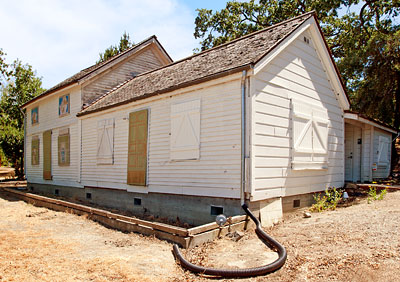National Register of Historic Places in Contra Costa County
Patrick Rodgers Farm
AKA Rodgers Ranch
315 Cortsen Road
Pleasant Hill
Built c.1868
In 1868, Patrick Rodgers moved his family from the California Mother Lode country to this Contra Costa ranch. Upon Mr. Rodgers death in 1891, the property was divided among his heirs. At least a portion of the acreage remained in the Rodgers family until 1915. Thereafter, it passed through several owners, although it continued as a working farm until 1978.
The Patrick Rodgers Farm includes the 1868 farm house which was enlarged in the early 1900s and the barn dating to around 1868. The farm house was built as a rectangular two-story, horizontal wood sided building with gable roof. In the early 1900s a single story, L-shaped addition was added to the house, along with a covered porch which wraps around the east and south elevations.
When the property was about to be subdivided for single-family houses in 1987, the Pleasant Hill Historical Society rescued it.

The Patrick Rodgers Farm is significant for its association with the wheat industry. Wheat was the dominant crop In Contra Costa County in the second half of the nineteenth century and the Rodgers Farm is a rare survivor of a wheat farm from this era.
For decades in the second half of the 19th century wheat was the dominant crop in Contra Costa County, and the highest wheat production was recorded in the 1880s when wheat was king. Farm machinery had become more efficient, and the condition of the county roads gradually improved, providing the farmers with easier access to the warehouses and flour mills.
Carquinez Strait was deep, and ocean vessels could dock at its ports. Markets for the wheat were available, and it was exported from the county to all parts of the world. With the completion of the Central Pacific Railroad to the ports of Contra Costa County (especially Port Costa), the exporting of wheat flourished.
Adapted from the NRHP nomination.

The ranch is also significant for its association with Alice Tisdale Hobart who lived in the house from 1937 to 1939. During these years Hobart wrote Their Own Country and worked on The Cup and the Sword. Hobart established herself as a successful novelist in 1933 with the publication of Oil for the Lamps of China and consistently made the best seller lists with subsequent books.
Adapted from the NRHP nomination.



